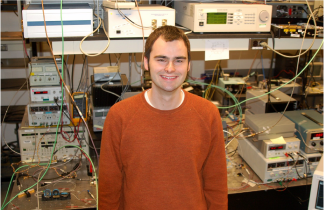 (Left: Schematic of pump-probe experiment to investigate femtosecond time-scale demagnetization on a magnetic film; from Bigot et al., Nature, 465, 458 (2010).)
(Left: Schematic of pump-probe experiment to investigate femtosecond time-scale demagnetization on a magnetic film; from Bigot et al., Nature, 465, 458 (2010).)As we await decisions on contributed papers in the next couple of weeks and for the technical program to be scheduled, the list of tutorials and invited talks for CLEO 2011 is rounding out. Two provoking titles that recently caught my eye were tutorial talks "Femtomagnetism" to be given by Jean-Yves Bigot from CNRS in Strasbourg, France under CLEO: QELS Fundamental Science 4: Optical Interactions with Condensed Matter and Ultrafast Phenomena as well as "Therapeutic Applications of Light: Photodynamic Therapy, the Killer and Low Level Light Therapy, the Healer" to be given by Michael Hamblin from Massachusetts General Hospital, under CLEO: Applications & Technology 1: Biomedical.
Femtomagnetism refers to magnetization dynamics which occur on a femtosecond time-scale. Over the last decade, Dr. Bigot and his colleagues have been using ultrafast laser pulses to induce changes in the magnetization of ferromagnetic materials on unprecedented time-scales. Besides probing the fundamental nature of magnetism, this work provides insight into the future of magnetic data storage, particularly finding a way to increase the speed of recording data. A ground breaking paper Phys Rev Lett. in 2007, by Stanciu et al. showed how the previously-thought fundamental speed limit to magnetic data recording could be broken by using ultrafast laser pulses to reverse the magnetization of magnetic bits during writing.
In a recent Nature article, Bigot et al. describe short time-scale, spin-orbit dynamics during femtosecond, laser-induced demagnetization. Using a femtosecond pump pulse to quickly demagnetize a ferromagnetic thin-film immersed in a magnetic field, Bigot and his collaborators extract information about the spin and orbital angular momentum as a function of time in a cross-correlation technique using x-ray pulses (See Fig.1). Spin and orbital angular momentum contributions during the process are measured by time-resolved x-ray magnetic circular dichroism (XMCD), a technique in which circularly polarized x-rays absorb in different proportions at different energies depending on the spin and orbital angular contributions of the material. This recent work investigates the magnetism dynamics in thin films whose magnetization is perpendicular to the plane of the film- a class of materials sought after for high-density data storage, and for which spin-orbit coupling plays a large role.
After reading some background on this fascinating and complex work, I was reminded of a famous interview with Richard Fenynman where a BBC reporter asks him to explain magnetism (click here to see the youtube clip). In Feynman's clever way he basically tells the reporter he can't do it because there is nothing in the reporter's sphere of knowledge and experience that would help him understand. Magnetism is beautiful, complicated, and at the fundamental quantum level, extremely non-intuitive (you really can't get by on analogies of spinning tops and orbitting planets, that's just plain wrong). If like me, you need some background, a good start is Bigot's 2002 review paper. Of course, why not hear it from the horses mouth and mark the tutorial on your conference planner.

(Above: plots showing enhanced cellular uptake of the photosensitizer ZnPc-(Lys) compared with other sensitizers, and corresponding images of cells; from Hamblin et al., ChemMedChem, 5, 890, (2010).)
Professor Hamblin's work on the other hand uses light in a very different way- to activate chemicals that can target and selectively kill harmful cells like infectious microbes or malignant cancer cells (photodynamic therapy), as well as to activate the production of intrinsic detoxifying chemicals within damaed cells to stimulate tissue healing (low level light therapy). In photodynamic therapy (PDT), photosensitizers are introduced into the body locally or topically and taken-up by the harmful cells. Illuminating the targeted cells with light excites the photosensitizers and produces reactive oxygen species harmful to the targeted cell.

(Above: Table showing inhibition of tumor growth when using photodynamic therapy with ZnPc-(Lys) ; from Hamblin et al., ChemMedChem, 5, 890, (2010).)
One of the aims of Hamblin's group is to create more efficient photosensitizers- ones that are more readily taken up by targeted cells and that are more lethal. Hamblin recently synthesized a photosensitizer, Pentalysine Beta-Carbonylphthalocyanine Zinc (ZnPc-(Lys)), that showed better cellular up-take, better selectivity to targeted cells, and a 20 times increase in photo-toxicity. Figure 2. shows the increase in uptake compared to conventional sensitizers and Table 1. shows the results of tumor-growth inhibition in Kunningmig mice that were treated with PDT using ZnPC-(Lys). For more information on killing and healing power of light, visit Professor Hamblin's very accessible and informative web pages. Better yet, be sure to attend the tutorial on phototherapy!

No comments:
Post a Comment